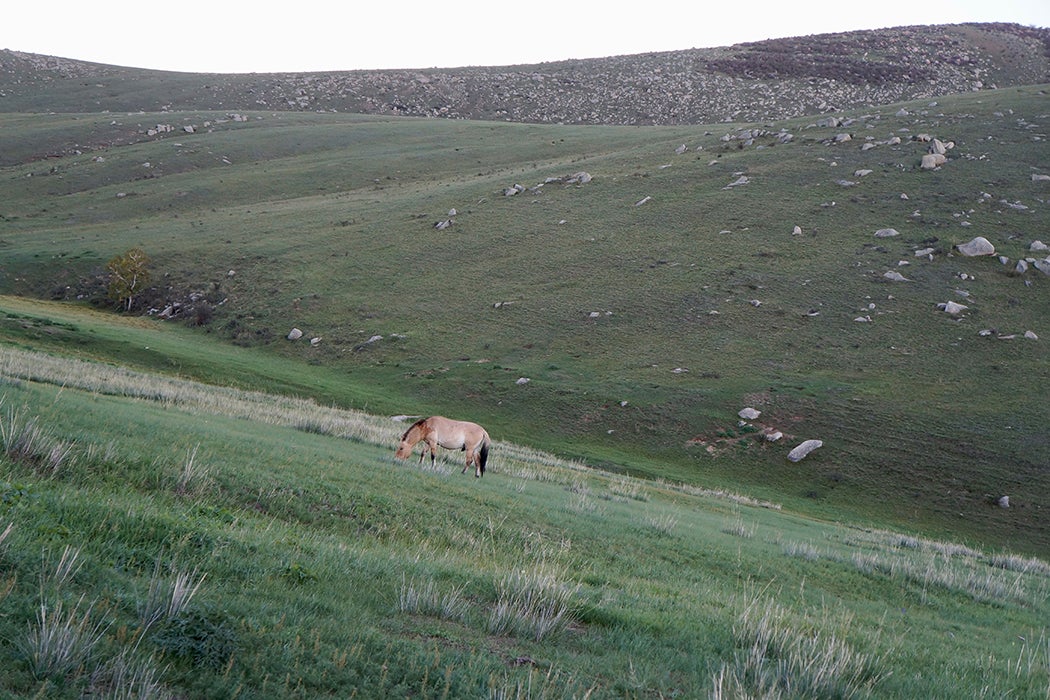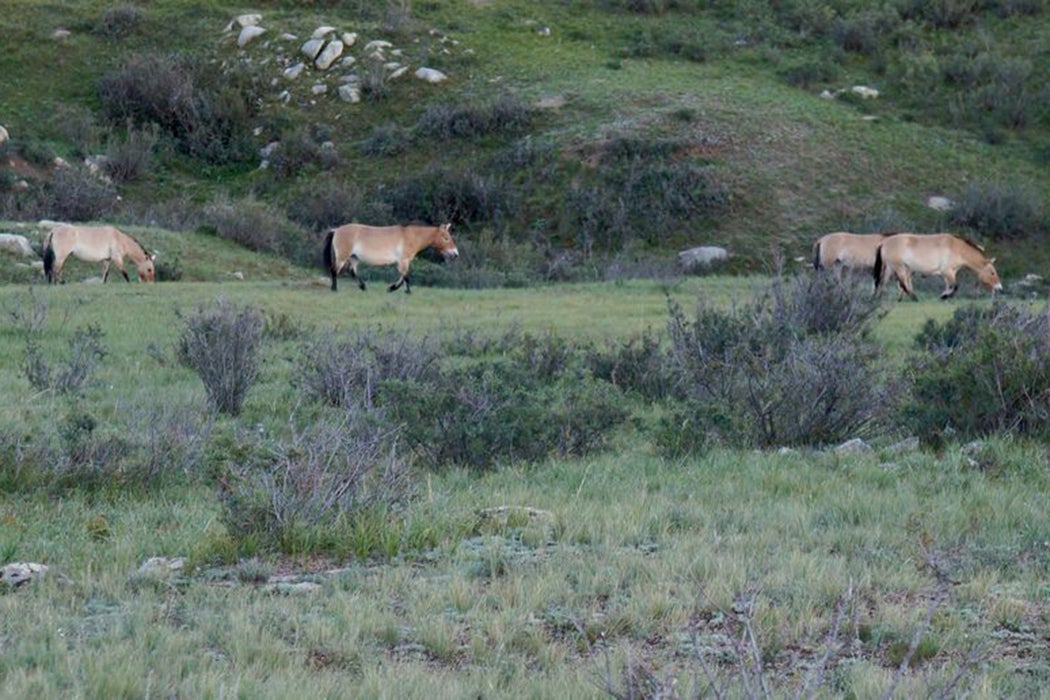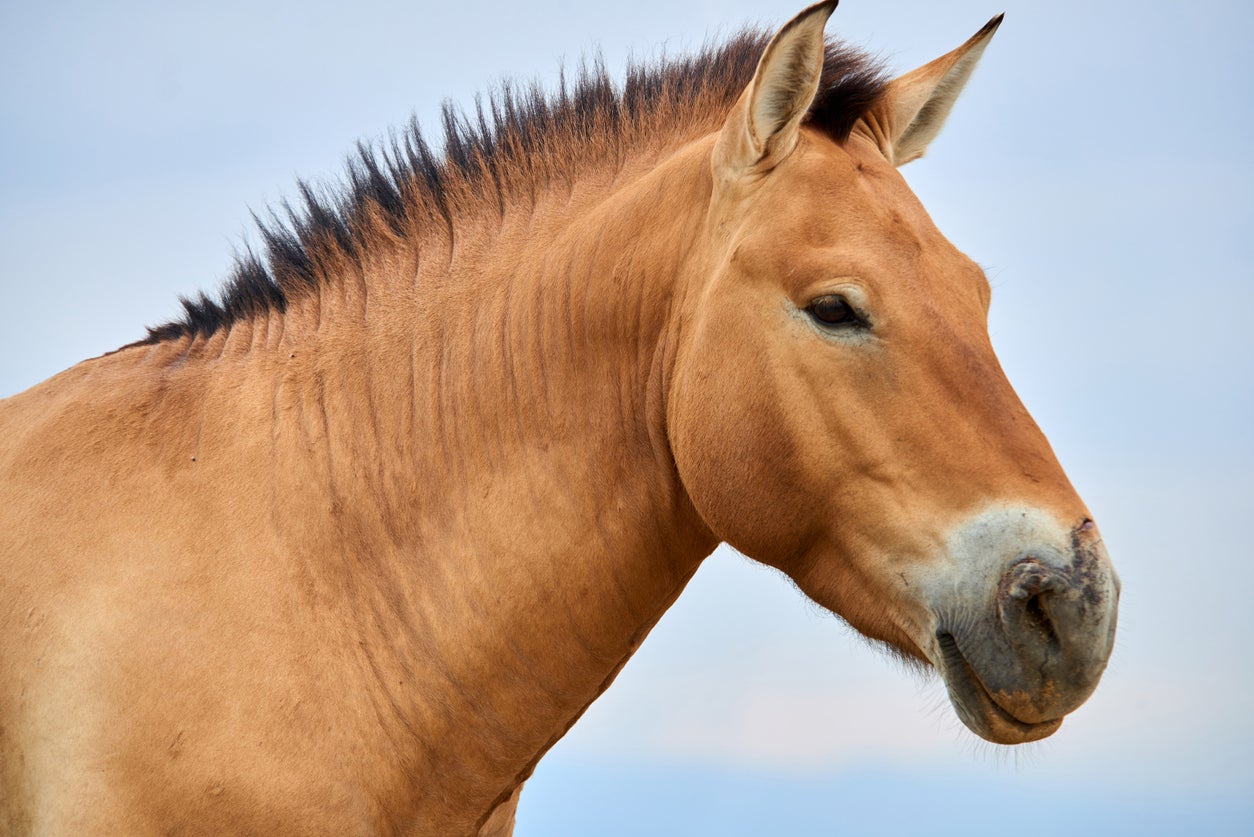For over 160,000 years, wild horses have roamed freely over the Central Asian steppe. Less than a century after they were encountered by Russian and European explorers, the horses, called takhi in Mongolian, were nearly extinct. In 1969, three years after the last reported sighting of a live takhi, the International Union for Conservation of Nature declared the species extinct in the wild. But thanks to the persistent conservation efforts of several decades, including ongoing education and rewilding programs, hundreds of takhi now roam freely in Mongolia’s Hustai National Park, just sixty miles outside of Ulaanbaatar, thumbing their hooves in defiance of their evolutionary odds.
Equine legacies have been part of Mongolia’s heritage for centuries. Horses, along with yaks, camels, sheep, and goats, have been the backbone of Mongolia’s herding economy for millennia, and bones from domesticated horses have been found at Bronze Age archaeological sites across Central Asia. From the equestrian prowess of Chinggis Khan’s thirteenth-century army to the competitive display of horsemanship during Mongolia’s annual Naadam Festival, domesticated horses remain the living icons of Mongolian culture today.
But takhi is a horse of a different color—and a different species, for that matter. Taxonomically, the wild horses belong to Equus przewalskii. Colloquially, they’re called Przewalski horses, named after the nineteenth-century Russian explorer, Nikolai Przewalski, credited with the species’ discovery. Gifted with a horse skull and hide during his Mongolian travels, Przewalski brought the remains back to St. Petersburg for study at the Zoological Museum of the Russian Academy of Science in 1881, and the museum’s conservator, I.S. Poliakov, named the new species after him.

The discovery didn’t serve takhi well. Dun-colored, with a dark mane and small but stocky body, they were attractive, good-looking creatures that quickly became a prize for zoos and private exotic animal collectors. Between 1897-1903, foreign expeditions rushed to supply the demand for wild horses, capturing 88 foals of which only 54 survived long enough to be transported to European zoos. In order to take takhi foals, expedition hunters would slaughter the wild stallions, scattering the stallion’s harem of mares, which disrupted the herds’ natural breeding cycle dynamics. The takhi sent to the European and United States zoos did not do well, and by the 1950s only 12 breeding wild horses were still alive in captivity.
At the same time, in Mongolia, wild herds were pushed out of their main habitats, overhunted as trophy and food sources with the growing use of firearms, and withered in the hard taiga winter draughts of 1944 and 1956. After 1966, no live takhi was sighted in Mongolia.
Luckily the conservationists really rallied around the same time, doubling down on their efforts, and the number of captive equines in Europe slowly grew to 134 individuals by 1965. In 1977, Jan and Inge Bouman from the Netherland created the Foundation for the Preservation and Protection of the Przewalski Horse (FPPPH), with two specific goals in mind: To develop a computerized studbook that could carefully document the genetic lineages of different takhi population (using regularly updated notes from the takhi’s keeper in the Prague zoo), and to release wild horses back into their natural steppe habitat. The Boumans were soon joined in their efforts by the Mongolian biologist, Dr. Tserendeleg Jachin. Financially backed by the World Wildlife Federation-Netherlands, the Foundation purchased several takhi from European zoos to begin their program.
But after generations of living in captivity, takhi lost their survival behaviors and couldn’t be immediately released into the wild. So for a decade and a half, the FPPPH took takhi herds to live in semi-wild conditions of nature preserves in the Netherlands and Germany. That proved successful and in 1992, the foundation was confident enough to ship the first set of takhi to their native lands. On June 5 of 1992, which coincided with World Environmental Day, the foundation flew and released fifteen horses to Hustai nature reserve, which a year later, was designated a National Park by the newly-formed Mongolian democratic government. Subsequently, every two years, with a total of five transports, additional horses were brought over. By 2001 the takhi census showed 84 horses, and today over 350 of them live in Hustai National Park.

The park covers over 50,000 hectares, or roughly 123,000 acres, and has a plethora of steppe wildlife, each busily carving out their own ecological niches, from marmots to ibex to lichens to fish. But the wild horse remains the park’s flagship species. In 2003, the then-newly formed and self-financed NGO, Hustai National Park Trust, signed an agreement with the Mongolian government to take over the administration and the science of managing the park and the takhi. The FPPPH has scaled back its involvement as the Trust, run by Mongolian scientists, park rangers, and conservationists, took the lead on running the park.
The trust monitors the takhi populations, particularly during breeding seasons, with rangers and students armed with binoculars. Park rangers flush out marmot poachers whose traps disrupt the takhi and other species. Red deer and Mongolian gazelles, which had been overhunted in decades before the reserve was established, also became conservation success stories. A museum ger (yurt) at the visitors’ camp in the park outlines the horses’ history and the park’s conservation efforts.
It’s not enough, however, to simply breed a bunch of wild horses, release them, and expect the still-endangered species to be successful. In order for a repopulation program to be effective, it needs social buy-in from any number of groups because reintroduction is a long-term project. In the case of the takhi, this means that the trust must maintain a buffer zone between Hustai’s unfenced boundaries and local herders’ livestock that grazes in the steppe. These efforts prompted a push for eco-tourists to stay with local nomadic herders who live near the buffer zone—to learn about their lives and economies. Hustai tourists can pay to adopt (and name!) a foal from the upcoming breeding season, with proceeds helping sustain rangers and continue the local families outreach in the buffer zone.
“Involving local people in conservation and research activities is an essential consideration to ensure such projects are successful,” the museum display reminds visitors. “Hustai National Park Trust works closely with people living within the buffer zone of Hustai National Park to support and establish relationships with herder communities.”
In short, science and society are inexorably intertwined threads in the story of successful species reintroduction.

In a twist of biting historical irony, the takhi have been repopulated through the captive descendants of the very individuals taken from Mongolia over a hundred years ago—the actions that tipped the horses toward extinction in the first place. Today there are over 2000 takhi in zoos, semi-wild reserves, and reintroduction sites around the world in more than 30 countries, spanning five continents. There are two other preserves in western Mongolia as well as two in northern China.
All of them are descendants of only 12 horses that remained alive at the time—a message to the world of just how much the species’ evolutionary fate could have gone either way.
The twenty-first century has seen a push to “rewild” extinct species, what biologists jokingly refer to as the Jurassic Park effect. While bringing long-extinct species back to life has the exciting spectacle of science fiction (for example, Russia’s Pleistocene Park) it is worth remembering that serious conservation efforts have positive effects on rewilding not-quite-extinct species, such as the Mongolian takhi. Today takhi are a model for other troubles species’ reintroduction efforts.
Its story is one of the few rewilding successes, and their extinction is no longer a foregone conclusion.







